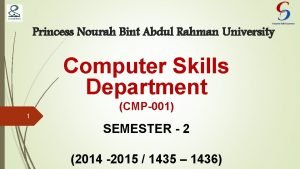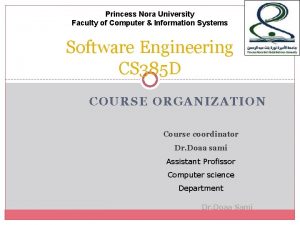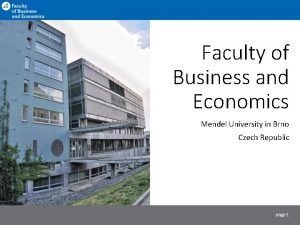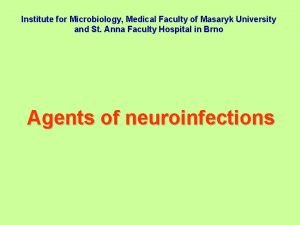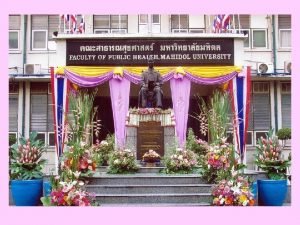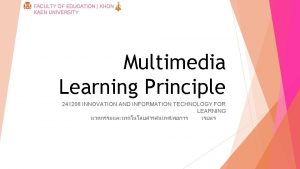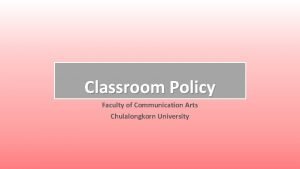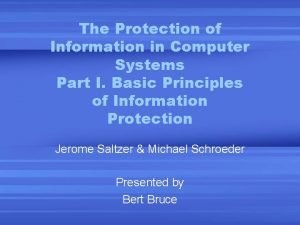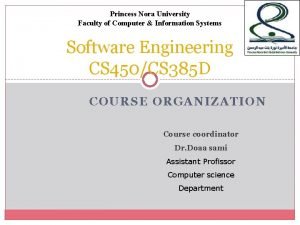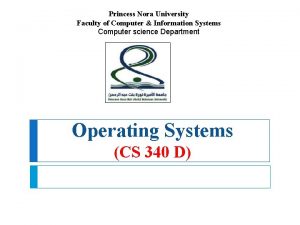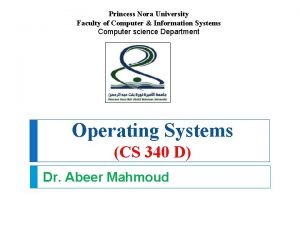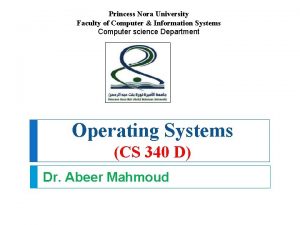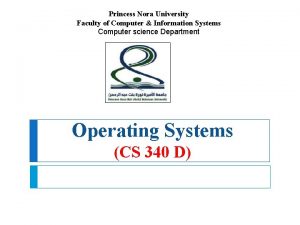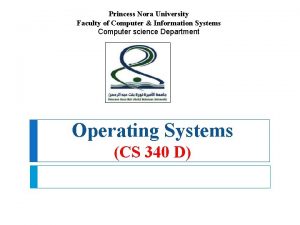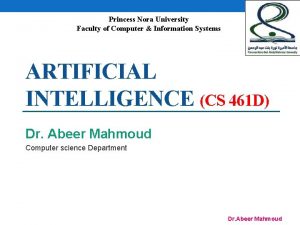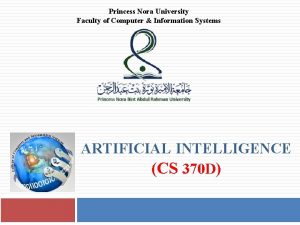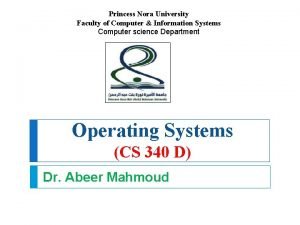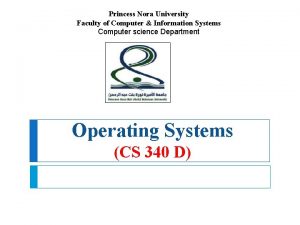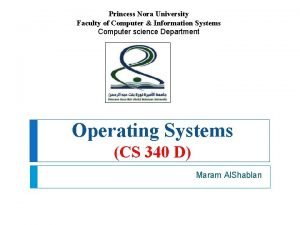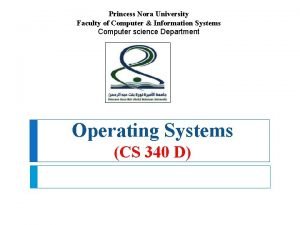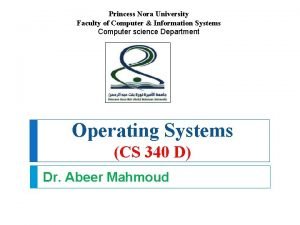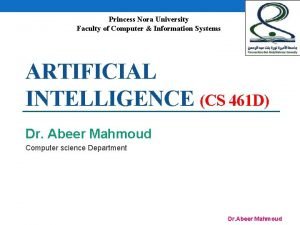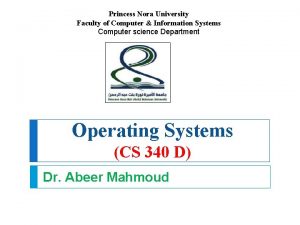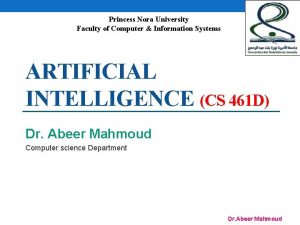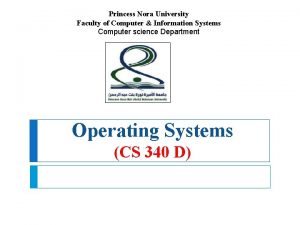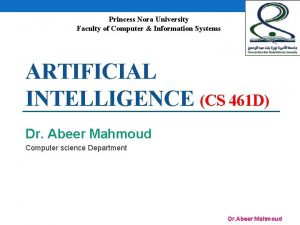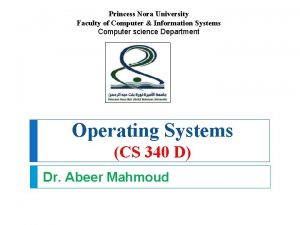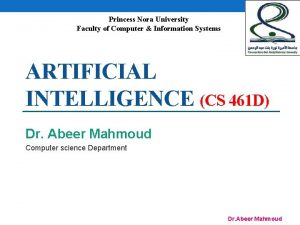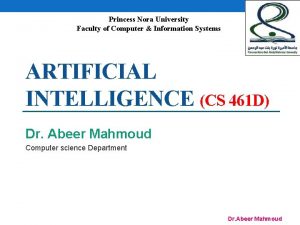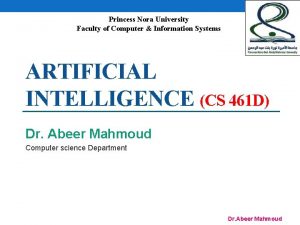Princess Nora University Faculty of Computer Information Systems






































- Slides: 38

Princess Nora University Faculty of Computer & Information Systems Computer science Department Operating Systems (CS 340 D) Dr. Abeer Mahmoud

(Chapter-1) Introduction

Chapter 1 Introduction 1. What Operating Systems Do 2. Computer-System Organization 3. Computer-System Architecture 4. Operating-System Structure 3 Dr. Abeer Mahmoud

OBJECTIVES: Ø To describe the basic organization of computer systems. Ø To provide a grand tour of the major components of operating systems. Ø To give an overview of the many types of computing environments. 4 Dr. Abeer Mahmoud

What is an Operating System? 5 Dr. Abeer Mahmoud

What is an Operating System? Ø A program that acts as an intermediary between a user of a computer and the computer hardware � Operating system goals: � Execute user programs and make solving user problems easier � Use 6 the computer hardware in an efficient manner Dr. Abeer Mahmoud

Operating System Functions q q q 7 Process Management Memory Management File Management Device Management Command Interpretation Security Dr. Abeer Mahmoud

Computer System Structure � 1. Consists of four components Hardware : provides basic computing resources (CPU, memory, I/O devices) 2. Operating system: Controls and coordinates (use, hardware, applications) 3. Application programs : “define the ways in which the system resources are used to solve the computing problems of the users” ex: (Word processors, compilers, web browsers, database systems, video games) 8 Dr. Abeer Mahmoud

Four Components of a Computer System 9 Dr. Abeer Mahmoud

The operating system’s Role 1 - User View: example OS is designed to Single User personal computer ease of use Multiple User’s mainframe l minicomputer maximize resource utilization Workstations users connected to networks or servers compromise between individual usability and resource utilization. Handheld computers Single user & may connected to networks individual usability and performance per unit of battery life is important as well. Embedded computers If the computers have little or no user view run without user intervention (minimize usability) category 10 Dr. Abeer Mahmoud

The operating system’s Role (cont. ) 2 - System View: OS is a resource allocator • Manages all resources (e. g. CPU time, memory space, file-storage space, I/O devices…etc) • Decides between conflicting requests of many users access the same mainframe or minicomputer 11 OS is a control program • Controls execution of programs to prevent errors • It is especially concerned with the operation and control of I/O devices. Dr. Abeer Mahmoud

Operating System Definition � Operating System Definition: � It is a software that manage the computer hardware and provide an environment for application programs to run � “The one program running at all times on the computer” is the kernel. � Everything 12 else is either a qsystem program qapplication program Dr. Abeer Mahmoud

Computer-System Organization 13 Dr. Abeer Mahmoud

Computer-System Organization 1. Computer-System Operation 2. Storage Structure 3. I/O Structure 14 Dr. Abeer Mahmoud

Computer System Organization 1 -Computer-system operation � A general-purpose computer system consists of three main components 2 - Multiple device controllers: connected through a common bus 1 -One or more CPU 15 3 - RAM: connecting to CPU and device controllers through common bus Dr. Abeer

Computer System Organization 1 -Computer-system operation(cont. . ) � Each device controller is responsible of a specific type of device (e. g. disk drives, audio devices, and video displays). � The CPU and the device controllers can execute concurrently, competing for memory cycles. � So, a memory controller is provided whose function is to synchronize access to the memory. 16 Dr. Abeer Mahmoud

Computer System Organization 1 -Computer-system operation(cont. . ) Computer Startup: � bootstrap program is loaded at power-up or reboot � Typically stored in ROM or EEPROM, generally known as firmware � Initializes all aspects of system � Loads operating system kernel and starts execution ROM : read-only memory, Once data has been written onto a ROM chip, it cannot be removed and can only be read. EEPROM: electrically erasable programmable read-only memory. EEPROM is a special type of PROM that can be erased by exposing it to an electrical charge. 17 Dr. Abeer Mahmoud

Computer System Organization 1 -Computer-system operation(cont. . ) Interrupt: � It generated from either the hardware or the software Hardware sending a signal to the CPU through system bus. � Software send through a system call. � The interrupt is signal that gets the attention of the CPU and is usually generated when I/O is required. For example: • hardware interrupts are generated when a key is pressed or when the mouse is moved. • Software interrupts are generated by a program when I/O is required. 18 Dr. Abeer Mahmoud

Computer System Organization 2 -Storage Structure � Main memory – only large storage media that the CPU can access directly � Secondary storage – extension of main memory that provides large nonvolatile storage capacity � Magnetic disks – rigid metal or glass platters covered with magnetic recording material � Disk surface is logically divided into tracks, which are subdivided into sectors � The disk controller determines the logical interaction between the device and the computer 19 Dr. Abeer Mahmoud

Computer System Organization 2 -Storage Structure(cont. . ) � All forms of memory provide an array of words. Each word has its own address. � Interaction is achieved through a sequence of load or store instructions to specific memory addresses. � The load instruction>>> moves a word from RAM to CPU’s register � The store instruction>>> moves the content of a CPU’s register to RAM � CPU automatically loads instructions from main memory for execution. 20 Dr. Abeer Mahmoud

Computer System Organization More expensive and faster 2 -Storage Structure (cont. . ) 21 volatile can be volatile or non volatile Nonvolatile Dr. Abeer Mahmoud

Computer System Organization 3 -I/O Structure �A large portion of OS code is dedicated to managing I/O, because of: Its importance to the reliability and performance of a system � The varying nature of the devices. � 22 Dr. Abeer Mahmoud

Computer System Organization 3 -I/O Structure(cont. . ) �A device controller maintains some local buffer storage and a set of special-purpose registers. � The device controller is responsible for moving the data between the peripheral devices that it controls and its local buffer storage. � Operating systems have a device driver for each device controller. This device driver understands the device controller 23 Dr. Abeer Mahmoud

Computer System Organization 3 -I/O Structure(cont. . ) DC : Responsible for moving data between Peripherals devices that it controls eg: keyboard Device Controller (DC) Local buffer storage + Understand how? OS 24 Set of special purpose registers Device Driver (DD) Dr. Abeer Mahmoud

Computer System Organization 3 -I/O Structure(cont. . ) � (Algorithm #1) � DD loads the appropriate registers within the DC � DC, examines the contents of these registers to determine what action to take (such as “read “a character from the keyboard”). � DC transfers data from the device to its local buffer. When finish informs DD via an interrupt � DD returns control to OS, � This form of interrupt-driven I/O is fine for moving small amounts of data otherwise produce high overhead 25 Dr. Abeer Mahmoud

Computer System Organization 3 -I/O Structure(cont. . ) � (Algorithm � What is direct memory access (DMA) ? � After setting up buffers, pointers, and counters for the I/O device, � DC transfers an entire block of data directly to or from its own buffer storage to memory, with no intervention by the CPU. � 26 #2 moving large data without overhead) Only one interrupt is generated per block, to tell the device driver that the operation has completed, rather than the one interrupt per byte generated for low-speed devices. Dr. Abeer Mahmoud

Computer-System Architecture 27 Dr. Abeer Mahmoud

Computer-System Architecture � Single-processor � systems : one CPU MULTIPROCESSOR SYSTEMS � Also known as parallel systems, tightly-coupled systems � have two or more processors in close communication, sharing the computer bus and some times the clock, memory, and peripheral devices. � Advantages include: 1. Increased throughput : more work is performed 2. Economy of scale : cost less 3. Increased reliability : the failure of one processor will not halt the system, only slow it down. 28 Dr. Abeer Mahmoud

Computer-System Architecture (cont. . ) � MULTIPROCESSOR SYSTEMS – (CONT. ): Asymmetric Multiprocessing o Each processor is assigned a specific task. o master-slave relationship o A master processor controls the system; It schedules and allocates work to the slave processors. 29 Symmetric Multiprocessing (SMP) o Each processor performs all tasks within the operating system. (peer =equal rank) o Each processor has its own set of registers & cache o All processors share physical memory. Dr. Abeer Mahmoud

Symmetric Multiprocessing Architecture 30 Dr. Abeer Mahmoud

Computer-System Architecture (cont. . ) q SMP � pros (++): many processes can run simultaneously —N processes can run if there are N CPUs— q SMP Cons (--): OS must carefully control I/O to ensure that the data reach the appropriate processor. � since the CPUs are separate, one may be sitting idle while another is overloaded, resulting in inefficiencies. � � All modern operating systems—including Windows, Mac OS X, and Linux—now provide support for SMP. 31 Dr. Abeer Mahmoud

Computer-System Architecture (cont. . ) o o o Processors were originally developed with only one core. The core : is the part of the processor that actually performs the reading and executing of the instruction. Single-core processors can process only one instruction at a time �Multi-cores o chips. It is a recent trend in CPU design is to include multiple computing cores on a single chip. 32 Dr. Abeer Mahmoud

A Dual-Core Design o. Multi-cores chips can be more efficient than multiple chips with single cores because: 1. on-chip communication is faster than between-chip communication l. Dual-core processor contains two cores (Such as Intel Core Duo). l. Multi-core systems are especially suited for server systems such as database and Web servers. 33 2. one chip with multiple cores uses significantly less power than multiple single-core chips. Dr. Abeer Mahmoud

Operating System Structure 34 Dr. Abeer Mahmoud

Operating System Structure – Single program cannot keep CPU and I/O devices busy at all times – Multiprogramming increases CPU utilization by organizing jobs (code and data) so that the CPU always has one to execute. 35 Dr. Abeer Mahmoud

Operating System Structure Multiprogramming environment – Multiprogramming idea is as follows: 1. The operating system keeps several jobs in memory simultaneously. 2. One job selected and run via job scheduling. 3. When it has to wait (for I/O for example), OS switches to another job 4. Eventually, the first job finishes waiting and gets the CPU back. 5. As long as at least one job needs to execute, the CPU is never idle. 36 Time sharing (or multitasking) system: o Multiple jobs are executed by switching the CPU between them. frequently that the users can interact with each program while it is running. o In this, the CPU time is shared by different processes, so it is called as “Time sharing Systems”. o Time slice is defined by the OS, for sharing CPU time between processes. o CPU is taken away from a running process when the allotted time slice expires. ex: Unix, etc. Dr. Abeer Mahmoud

Memory Layout for Multiprogrammed System – RAM is too small to accommodate all jobs, the jobs are kept initially on the disk in the job pool. – This pool consists of all processes residing on disk awaiting allocation of main memory. 37 Dr. Abeer Mahmoud

Thank you End of Chapter 1 38 Dr. Abeer Mahmoud
 Gstt johor
Gstt johor Princess nora university
Princess nora university Bridgeport engineering department
Bridgeport engineering department Computer science tutor bridgeport
Computer science tutor bridgeport Florida state university computer science
Florida state university computer science Brown university computer science
Brown university computer science University of split faculty of maritime studies
University of split faculty of maritime studies Hubert kairuki memorial university faculty of medicine
Hubert kairuki memorial university faculty of medicine Semmelweis university faculty of medicine
Semmelweis university faculty of medicine Applied medical sciences
Applied medical sciences Faculty of business and economics mendel university in brno
Faculty of business and economics mendel university in brno Singularity university faculty
Singularity university faculty Agnes csaki semmelweis
Agnes csaki semmelweis Masaryk university medical faculty
Masaryk university medical faculty Feup university of porto
Feup university of porto Ldap cuni
Ldap cuni Faculty of veterinary medicine cairo university logo
Faculty of veterinary medicine cairo university logo Faculty of law of the university of zagreb
Faculty of law of the university of zagreb University of montenegro faculty of law
University of montenegro faculty of law University of kragujevac faculty of technical sciences
University of kragujevac faculty of technical sciences University of cologne faculty of management
University of cologne faculty of management Leading university sylhet tuition fees
Leading university sylhet tuition fees Hacettepe university faculty of medicine
Hacettepe university faculty of medicine دانشگاه دامپزشکی تهران
دانشگاه دامپزشکی تهران Semmelweis university faculty of medicine
Semmelweis university faculty of medicine Lebanese university roumieh
Lebanese university roumieh Bachelor of education york university
Bachelor of education york university Elearningunideb
Elearningunideb Clemson ece
Clemson ece Faculty of veterinary medicine cairo university
Faculty of veterinary medicine cairo university Faculty of mechanical engineering thammasat university
Faculty of mechanical engineering thammasat university Faculty of business and economics mendel university in brno
Faculty of business and economics mendel university in brno Chronic meningitis
Chronic meningitis Slidetodoc.com
Slidetodoc.com Thin and thick smear
Thin and thick smear Faculty of education khon kaen university
Faculty of education khon kaen university Shawhong ser
Shawhong ser Cairo university faculty of veterinary medicine
Cairo university faculty of veterinary medicine The protection of information in computer systems
The protection of information in computer systems
